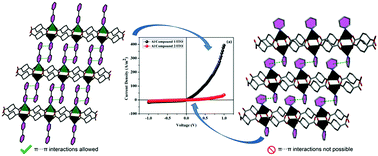Two zinc(ii)-based coordination polymers with flexible dicarboxylate and pyridine mixed ligands: effect of π⋯π interactions on electrical activity†
Abstract
Two novel coordination polymers (CPs) [Zn(cis-1,4-chdc)(4-phpy)]n, (1) and [Zn(cis-1,4-chdc)(py)]n, (2) (1,4-H2chdc = 1,4-cyclohexanedicarboxylic acid, 4-phpy = 4-phenylpyridine and py = pyridine) were synthesized and characterized by elemental analysis, infrared spectroscopy, single-crystal X-ray diffraction, powder X-ray diffraction and thermogravimetric analyses. Both compounds formed a one-dimensional (1D) chain-like structure constructed by Zn2(CO2)4 paddle-wheel dimers interconnected via double strands of cis-1,4-chdc-bridges, whereby pyridine-based ligands were decorated as arms on both sides of Zn2 dimers. In compound 1, polymeric 1D chains underwent self-assembly via π⋯π stacking interactions among 4-phpy ligands to form a 2D network, whereas this type of interaction was absent in 2. Interestingly, both compounds exhibited electrical conductivity and revealed Schottky barrier diode behavior. However, compound 1 showed better electrical conductivity (1.09 × 10−3 S m−1) with respect to compound 2 (6.01 × 10−5 S m−1) because of π⋯π interactions.



 Please wait while we load your content...
Please wait while we load your content...